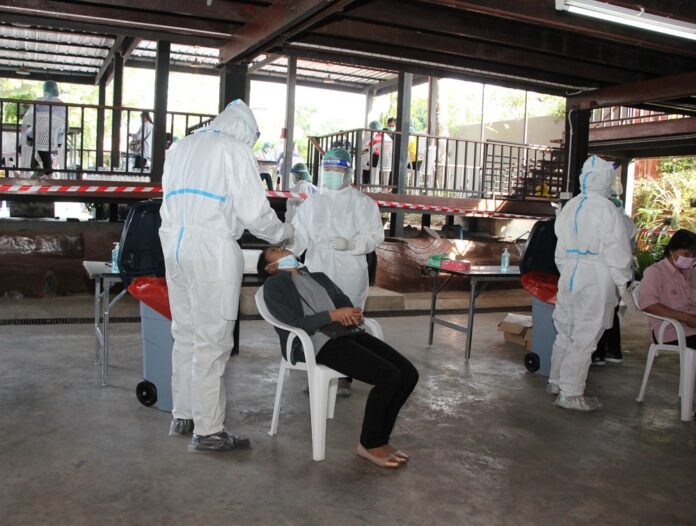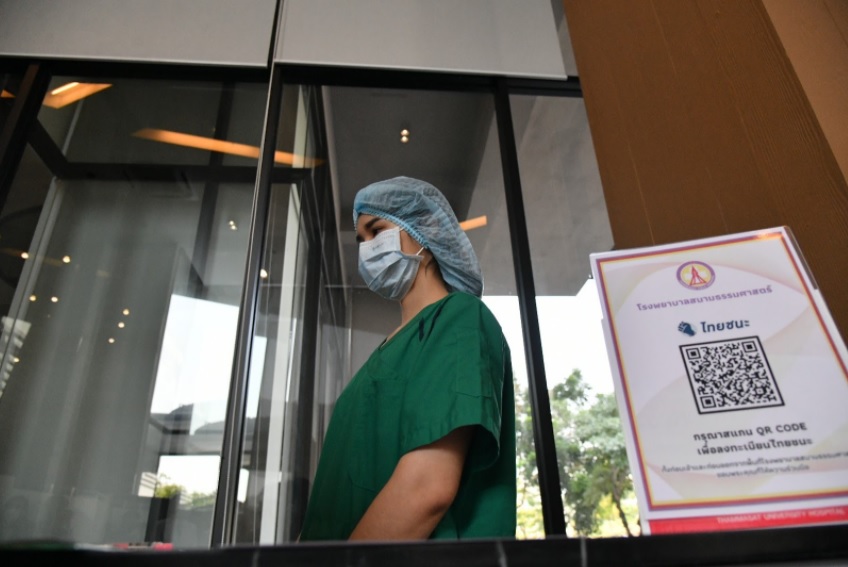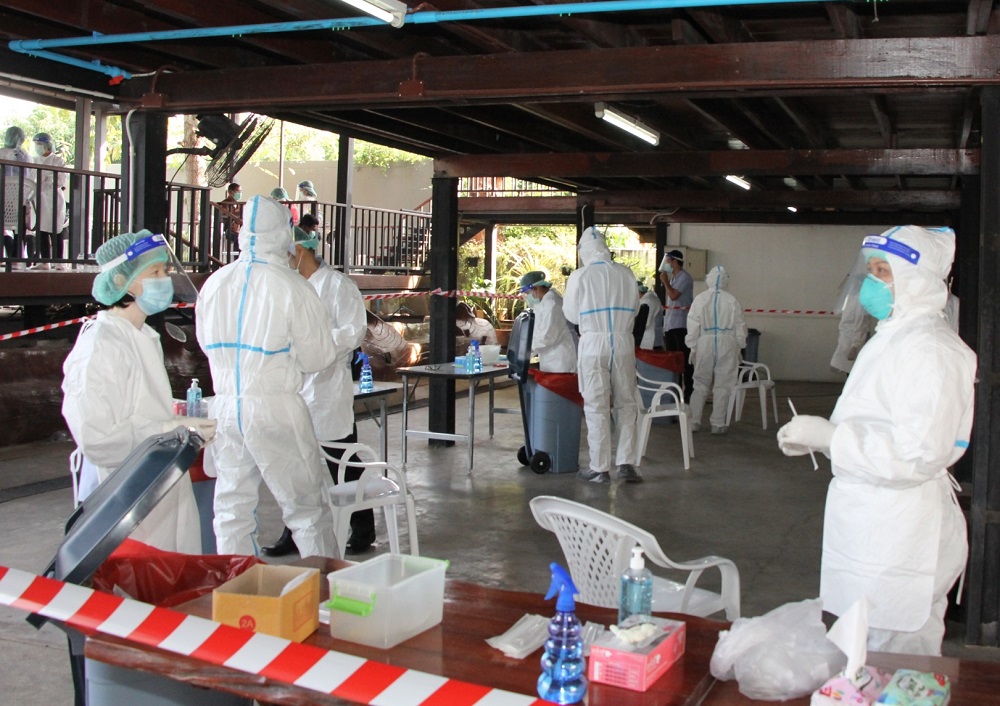
BANGKOK — Medical experts on Friday said the public should embrace the upcoming vaccination campaign to build a herd immunity against the coronavirus – and the Chinese-made vaccine secured by Thailand is adequate to do the job, contrary to what the media may have told you.
Two million doses of the vaccine developed by Chinese enterprise Sinovac are slated to be handed to at-risk groups in five provinces hardest hit by the current outbreak. Although many media agencies continue to sow doubt over its reported efficacy of “50.4 percent,” public health professionals said the vaccine is a timely lifeline for the public to develop a large-scale defense against the virus.
“Perhaps in a couple of years, the individual can worry about getting vaccines with a higher efficacy rate. By that time, vaccine companies will have developed them,” Chatchai Mingmalairak, director of the Thammasat University Field Hospital said.
“But as we all know, vaccines take years to develop, and at this point in time we can’t wait that long.”
The Sinovac jabs will arrive in Thailand at a time the public is grappling with the worldwide resurgence of the virus, which proves to be far more deadly than the last. In other words, Chatchai said, “We can’t be picky.”
‘Only’ 50 Percent?
Kittisak Pholtawornkulchai, an infectious diseases physician at Vajira Hospital, said that the Sinovac’s efficacy of 50.4 percent passed the threshold set by the World Health Organization – a number that could be mistaken as a near-miss by laymen, but perfectly acceptable in the medical world.
“Even for other diseases’ vaccines, the efficacy was cut off at 50 percent,” Kittisak said.
The 50.4 percent efficacy means that if 100 people got the vaccination, then 50 would have a significantly smaller chance of catching the coronavirus or falling ill because of the virus.
“The other 50 will develop a weaker immunity that can make the disease less severe if they catch it,” Kittisak said.

Herd immunity, according to the John Hopkins Bloomberg School of Public Health, is when most of a population is immune to an infectious disease, and indirectly protects the rest of the population who are not immune. Most of the people interacted with simply don’t have, and can’t pass on, the disease.
“It’s not just about having an individual get a 100 percent immunity. If 50 percent of people in society have an immunity, then the chance of contracting the illness is much lower,” Thammasat University’s Chatchai said.
The country’s top virologist Yong Poovorawan also told a state broadcaster on Thursday that a 50 percent of population immunity will be an adequate start to defeat the coronavirus.
“The only way to stop this disease is to calculate [and achieve] herd immunity,” Yong, who works for Chulalongkorn Hospital, said in an interview with NBT.
Why These Two?
The first shipment of 2 million doses from Sinovac will be reserved for the vulnerable populations in Chonburi, Rayong, Trat, Chanthaburi, and Samut Sakhon, the government said. The larger Thai population will receive 60 million doses from British pharmaceutical firm AstraZeneca in the coming months.
According to published clinical trial results, AstraZeneca’s jab has an efficacy of around 70 percent effective, depending on the patient.
Storage and distribution concerns played a role in why the vaccines from AstraZeneca and Sinovac were chosen by the government. Both can be stored at the fridge temperature of 2C to 8C, while the more famous vaccine developed by German pharma Pfizer needs to be stored at the subzero temperature of -70C.

Although the Pfizer vaccine has a reported efficacy of 95 percent, the logistical challenges it poses to hospitals in Thailand is a major obstacle, and might even decrease its efficiency if not handled properly, Chatchai said.
“Doctors are more used to the traditional vaccine – not just how it’s made, but also logistics in transporting and storing it,” the field hospital director said. “Although the Pfizer vaccine got a high efficacy percentage in a lab, that might not be the case in the real world.”
Doctors are also more familiar with the “traditional” method of how vaccines work, and Sinovac turned to the oldest trick in the playbook, which is using “dead” or inactivated cells from the virus, Chatchai said.
Because of its reliance on older, established technology, Sinovac’s doses have fewer questions to answer than newer technologies employed by AstraZeneca, the doctor added.
What’s Up with the Numbers?
Kittisak from Vajira Hospital also said the public should understand the context of coronavirus vaccine efficacy: there is simply no universal standard that governs the clinical trials at this time, and results vary because of varying factors.
“Academic studies have different methods of research,” Kittisak said. “Different countries also choose different people for their studies.”
For instance, while much of the media seized on a statement by the Butantan Institute in Brazil that the Sinovac jab is 50.4 percent effective for a combined groups of test subjects, they often fail to mention that the same institute said the vaccine is 78 percent effective in preventing mild cases that needed treatment, and 100 percent effective in staving off moderate to serious cases, depending on subject groups.
Sinovac’s vaccine is also reported by researchers in Turkey to be 91.25 percent effective, and 65.3 percent effective in Indonesia.
The disparity is due to the fact that all vaccine test data so far, whether they are develop in China, U.S., or Europe, rely on late-stage trials, and there has been not enough time for a peer reviewed study.
“Normally it wouldn’t take one or two years to make a vaccine. It would have been five years at least,” Yong, the Chulalongkorn Hospital virology expert, said in the NBT interview. “So, every company out there, I can tell you, their vaccine result study is not yet complete, because it’s a preliminary study, all of them.”
Ideally, vaccines have to be tested up to 10 years for a clear understanding of side effects and most efficient methods, said Chatchai from Thammasat University.
But the world beset by a global pandemic simply does not have that time. The gold standard right now is the safety threshold of 50 percent set by multiple regulators.
“Many times, you can get a good result in the lab but it fails in real life. So I don’t want you to worry about the 50.4 percent,” Chatchai said. “Right now, we need to get herd immunity.”
Yong also said the unique emergency posed by the coronavirus makes time too valuable to lose.
“[Vaccine companies] believe it’s necessary to bring the vaccine to stop the pandemic,” he said. “Because they already consider the benefit and harm of the vaccine. If its benefits far outweigh the harm, definitely, use in the emergency, until we are confident that it’s 99 percent effective, then we use it in the general situation as well.”















































